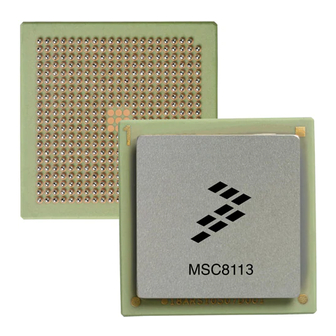
NXP Semiconductors MSC8113 Manuals
Manuals and User Guides for NXP Semiconductors MSC8113. We have 1 NXP Semiconductors MSC8113 manual available for free PDF download: Reference Manual
NXP Semiconductors MSC8113 Reference Manual (1202 pages)
Tri Core 16-Bit Digital Signal Processor
Brand: NXP Semiconductors
|
Category: Computer Hardware
|
Size: 16 MB
Table of Contents
-
-
Features30
-
Architecture37
-
-
SC140 Core39
-
M1 Memory40
-
Qbus System42
-
M2 Memory44
-
Timers51
-
Gpios52
-
-
-
-
-
Architecture58
-
-
-
Reserved Signals104
-
-
Architecture106
-
Hard Reset142
-
Soft Reset142
-
-
Boot Program
151-
Boot Basics152
-
-
Procedure Flow166
-
I 2 C System167
-
-
-
Clocks
169 -
Memory Map
181-
DSI Address Map241
-
Notes259
-
Extended Core
261-
SC140 DSP Core262
-
-
-
Memory Groups264
-
Errors266
-
Exceptions266
-
-
-
-
Architecture268
-
Fetch Unit269
-
Qbus Banks271
-
Bank Addressing272
-
Bank Registers272
-
-
-
-
Debugging289
-
-
Commands294
-
Modes294
-
Reads295
-
Restrictions295
-
Icache Registers296
-
-
-
-
Data Pipelining319
-
SDRAM Machine321
-
SDRAM Refresh328
-
Requests354
-
Clock Timing357
-
RAM Array358
-
RAM Words359
-
Last Word (LAST)367
-
Wait Mechanism368
-
-
System Bus
421-
-
Address Start425
-
Address Bus425
-
Data Arbitration429
-
Data Transfer430
-
-
-
Memory Coherency439
-
Pipeline Control455
-
-
-
-
Data Bus463
-
Address Bus466
-
-
-
Burst Transfers472
-
DSI Access Modes473
-
-
-
Status Registers495
-
-
-
-
DMA Access Modes506
-
-
Simple Buffer519
-
Cyclic Buffer520
-
Chained Buffer522
-
Data Transfers524
-
-
Architecture548
-
-
GIC Stop Mode552
-
DMA Interrupts557
-
-
-
Overview592
-
TAP Controller594
-
-
-
-
TDM Interface615
-
Gpios616
-
Timers616
-
Uart616
-
-
Stop Options618
-
-
-
TDM Interface
623-
TDM Basics628
-
Serial Interface637
-
TDM Local Memory643
-
TDM Power Saving653
-
Loopback Support654
-
-
Status Registers684
-
Uart
693-
Transmitter698
-
Break Characters701
-
Idle Characters702
-
Receiver702
-
Data Sampling704
-
Framing Error709
-
Parity Error710
-
Break Characters710
-
-
Run Mode714
-
Loop Operation715
-
Stop Mode715
-
-
-
Status Registers741
-
-
Gpio
745 -
-
Ethernet Basics771
-
-
MII Mode777
-
RMII Mode777
-
SMII Mode777
-
Special Modes778
-
Loopback Mode778
-
Echo Mode779
-
-
-
External Signals780
-
-
MII783
-
MII Receive Flow784
-
Rmii784
-
Smii786
-
-
-
Flow Control808
-
Error-Handling811
-
-
MAC Registers854
-
MIIGSK Registers866
-
RMON Support793
-
-
-
Interrupts923
Advertisement
Advertisement
Related Products
- NXP Semiconductors PowerQUICC MPC8308_RDB
- NXP Semiconductors MIMXRT1170HDUG
- NXP Semiconductors MIMXRT1170
- NXP Semiconductors MX93AUD-HAT-UM
- NXP Semiconductors MX93AUD-HAT
- NXP Semiconductors MCIMX93-EVKCM
- NXP Semiconductors MIMXRT1180-EVK
- NXP Semiconductors MCXN947VNLT
- NXP Semiconductors PowerQUICC MPC857T
- NXP Semiconductors MCXN546VNLT